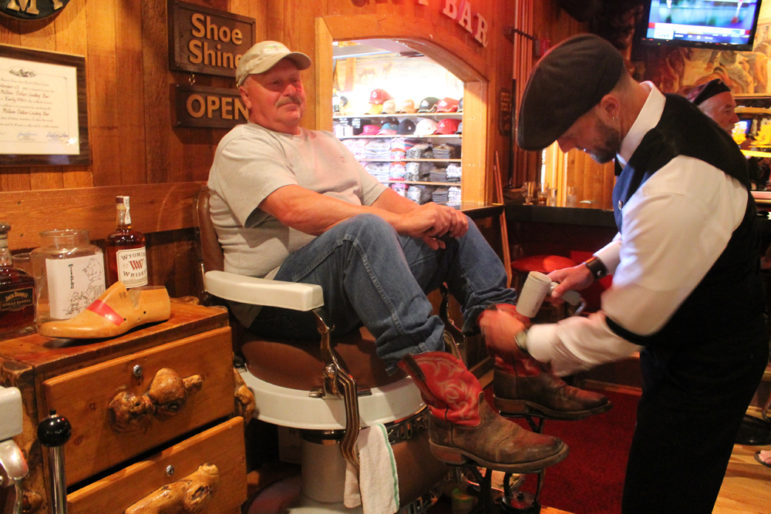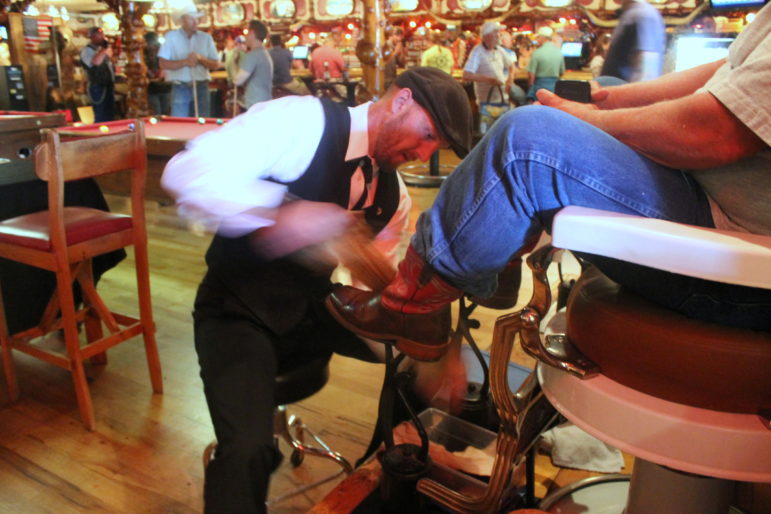
Tim Tetley works on Gordon Little’s boots at Tetley’s shoe-shine stand in the Cowboy Bar in Jackson, Wyo., south of Grand Teton National Park.
Few of Tim Tetley’s patrons at the Cowboy Bar in Jackson, Wyo. are likely to think to examine his sleeves. But Tetley still wears the same uniform, white shirt with black bands to roll the sleeves if it gets hot, black pants and a matching vest — the same his grandfather wore when he started shining shoes, and that his father wore when he joined the family trade.
For Tetley, a third-generation shoeshiner, the uniform is a way to honor his grandfather, who taught him how to shine shoes in a white shirt. It also doesn’t hurt in attracting tourists to his chair.
Walk into the Cowboy Bar, just south of Grand Teton National Park, on a busy night in the summer, and there might be a line of patrons waiting to climb into Tetley’s chair. People take pictures as he scoots around on his stool, examining soles and whipping towels across the tops of boots until they gleam.
Shoe-shining used to be a necessity to prolong the life of footwear, hand-made by cobblers. People owned few shoes in a lifetime and took care of them. Shining prolonged the life of shoes, healing cracks in leather and cleaning out dirt that caused early decomposition.
Today most of Tetley’s patrons view his chair as a novelty. Of his business, about 50 percent are tourists. For visitors it’s like a carnival ride to sit in the chair and have their footwear lathered back to pristine condition by someone dressed from an era passed, while in Jackson’s famous bar with its saddle seats.
Tetley polishes cowboy boots so recently purchased they are nearly pristine. People wear tennis shoes dusted with the dirt of the day’s hike that Tetley returns to in-store white. He cleans the white tips of the colored canvas sneakers to brighten up the whole shoe. He can work the intricate straps of women’s dress sandals. He’ll even clean Crocs.
It’s a different business from when Tetley’s grandfather, Henry Shook, first started shining shoes as a young man in St. Louis, Mo., in the 1920s after searching fruitlessly for work. At the time, many shoeshiners were black and worked only on shoes worn by white people. Shook, who was white, and looking for a way to create a niche market, decided he’d clean only the shoes of black people.
The stand at the barbershop where he worked was primitive. Shook didn’t have a stool and instead worked on his knees. He charged about 10 cents a shine.
Tetley’s father, Craig Tetley, started working beside Shook as a child and eventually joined his father’s business, although he expanded to serving people of all races.

Tim Tetley shines a pair of boots at the Cowboy Bar in Jackson, Wyo., south of Grand Teton National Park.
When Tim Tetley was a kid and got into trouble, his punishment was to shine all his dad’s shoes — he owned about 20 pairs. Still, some of Tetley’s fondest early childhood memories come from days spent at the shoe shine stand, where this dad let him help out and even start polishing shoes when he was 9 or 10 years old.
Watching his father and grandfather work, Tetley easily picked up the technique and skills, from the way the shoe is polished to the art of small talk. He liked meeting people from all walks of life and hearing their stories.
Shoe-shining is traditionally a profession for men and boys. Tetley’s sister never went into the business. Tetley, too, planned on following a different career path when he got older. He worked as a truck driver for six years and owned a diner. But he always came back to shoe shining.
Three years ago, he walked into the Cowboy Bar and saw the chairs, relegated to decoration after years of sitting empty. The last time someone regularly shined shoes at the stand was in the 1980s. He inquired about the space, and now works in the bar starting at 5 p.m., Tuesday through Saturday, staying open as late as business is steady. It usually takes him about 15 minutes to finish a pair of boots.
One night, he had a rancher who recently finished calving. His boots were covered in blood. Cleaning and shining took almost two hours. Tetley still charged him the $10 he always charges.
On quiet nights he’ll recruit a customer for a free shine. Sometimes all it takes is seeing someone in the chair to spark interest. It’s hard to know which nights will be busy and which slow, but he’s able to make a living, working year-round — except when the bar is closed in the off season.
For his regular customers, it’s a small luxury, like a hot shave for men, or a manicure for women. For a few minutes they can relax in the chair and sip a beer, while someone takes care of their shoes.
One regular customer comes in with his basic $1,700 cowboy boots with two huge diamonds for decoration.
Tetley rubs off the loose dirt and brushes the boots, then uses saddle soap to clean the shoes. Unlike his grandfather, Tetley uses a small hair dryer to dry the shoes, instead of toweling. Then he adds the wax, which keeps the moisture in and gives it the shine. Tetley keeps a black, brown and neutral colored wax. His grandfather used to keep 200 colors, but Tetley doesn’t have the storage space.
He finishes by brushing out the wax with the towels he whips over the shoes until the wax loses its pasty look and gleams.
“The trick to a shine is in the towel,” he said.
In some ways, shoe-shining has gotten harder. He now gets cowboy boots with intricate designs and colors and white stitching on dark shoes. It’s easy to ruin a pair of a shoes if someone doesn’t know what he is doing. It’s also why today he needs a business license and insurance.
Tetley, like many shoe shiners, won’t trust anyone else to shine his own shoes, so he does them himself. That’s another way to check the quality of a shoeshiner: look at his shoes.
Republished with permission from “Peaks to Plains,” a WyoFile.com blog focusing on Wyoming’s outdoors and communities. Kelsey Dayton is a freelance writer based in Lander. She has been a journalist in Wyoming for seven years, reporting for the Jackson Hole News & Guide, Casper Star-Tribune and the Gillette News-Record. Contact Kelsey at kelsey.dayton@gmail.com. Follower her on twitter @Kelsey_Dayton.
